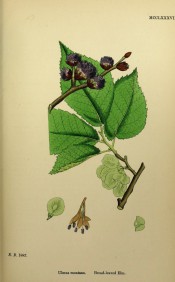Ulmus glabra Huds.
Fully hardy, rounded deciduous tree with obovate, toothed leaves, to 15cm long, lobed at the tips, turning yellow in autumn, and tiny red flowers in spring, followed by clustered, winged green fruit. To 40m. [RHSE, Hortus, Hilliers’].
Horticultural & Botanical History
‘U. montana resembles U. suberosa, but has fewer suckers or twigs produced from the trunk; the branches are longer and more spreading: the leaves 3 to 6 inches long, generally much larger; broader in proportion, and more acuminate or even cuspidate; the young branches generally more downy; the samara is variable in shape, but larger han in U. suberosa; but the chief difference is in the position of the seed-cavity, which is about the middle of the general outline of the wing; the notch in both species is variable in depth, and in each extends sometimes nearly down to the seed-cavity.
U. major, of Smith, the so-called Dutch elm, certainly belongs to U. montana, though in the figure in “English Botany ” the seed in the largest samara is placed near the apex of the wing, doubtless through the inaccuracy of the draughtsman, who has correctly delineated the other samaras in the fascicle. The var. nitida, is often confounded with var. glabra of U. suberosa, but it has all the essential characters of the normal U. montana.
Broad-leaved Elm. This species of elm is sometimes called the Scotch or Wych elm. It is of quicker growth than the former species, and the wood is consequently far inferior in hardness and compactness, and more liable to split. From the leaves somewhat resembling those of the hazel, Gerard tells us that in Hampshire “it is commonly called the witch hasell. Old men affirm,” he adds, “that, when long bows were in use, there were very many made of the wood of this tree, for which purpose it is mentioned in the English statutes by this name of witch hasell.” According to Gerard, the wych elm was applied to various uses in ancient times. It was not only made into bows, but its bark, which is very tough, was made into ropes. The wood was also considered good for the naves of carts, and for many of the purposes to which that of the common elm is now applied.’ [English Botany pl.MCCLXXXVI/1863-86]. From this description it is clear that this tree is Ulmus montana, the Broad Leaved Elm or Wytch Hazel, of The English Flora.
History at Camden Park
Listed in all published catalogues but no longer present in the gardens [T.979/1843].
Notes
Ulmus glabra Huds. is today regarded as the true Wych Elm and I assume that this is the tree grown by Macarthur and described here. The English Flora describes Ulmus glabra and Ulmus montana as separate species, describing Ulmus montana, the Broad Leaved Elm or Wytch Hazel, as having large rough leaves and Ulmus glabra, the Smoothed Leaved Elm or Wytch Elm, as having smooth leaves. [English Flora vol. II, p.22/1824].
Published Feb 28, 2010 - 03:29 PM | Last updated Feb 28, 2010 - 03:34 PM
| Family | Ulmaceae |
|---|---|
| Category | |
| Region of origin | Europe and Asia |
| Synonyms |
|
| Common Name | Wytch elm, Scotch elm |
| Name in the Camden Park Record |
Ulmus montana - Wych elm |
| Confidence level | high |
